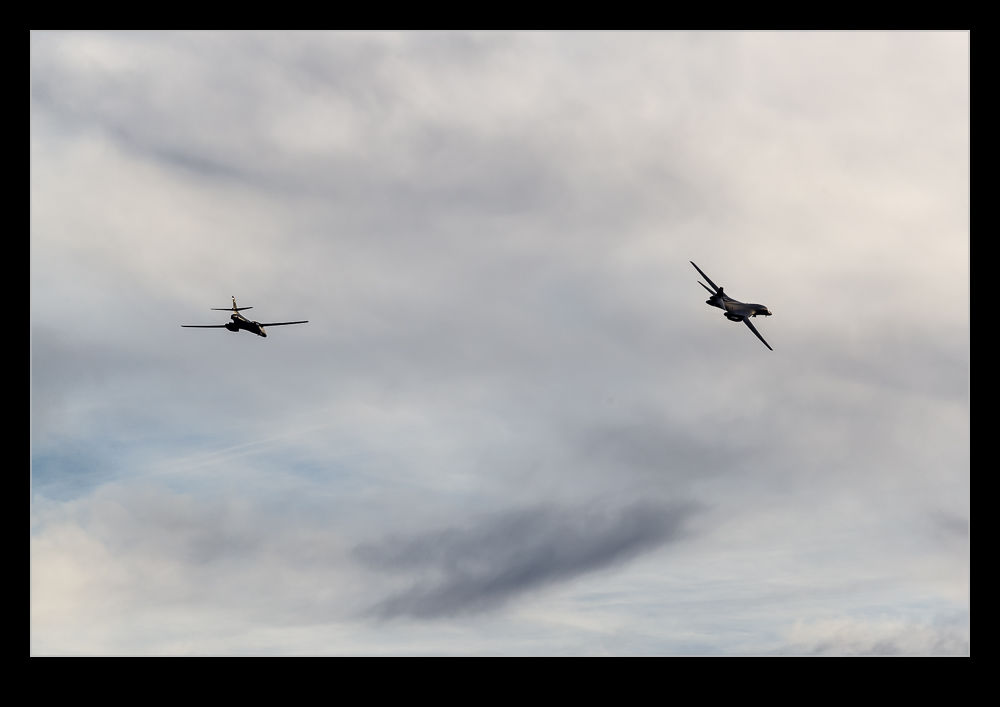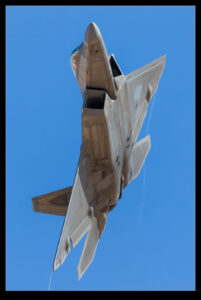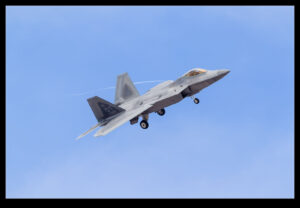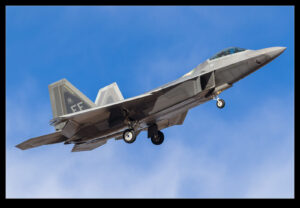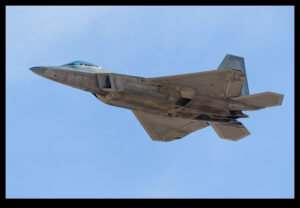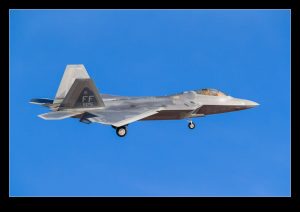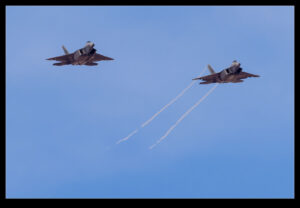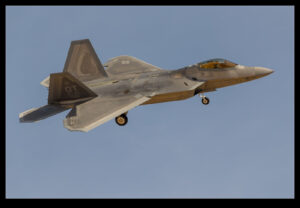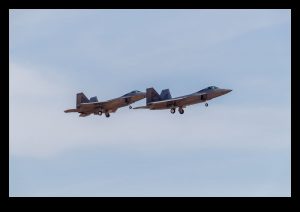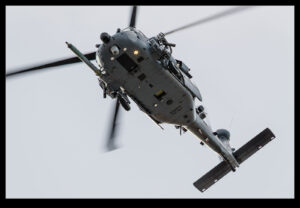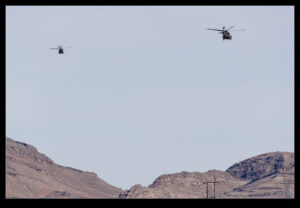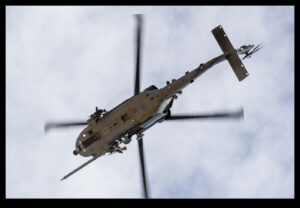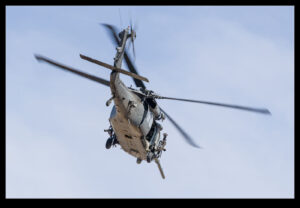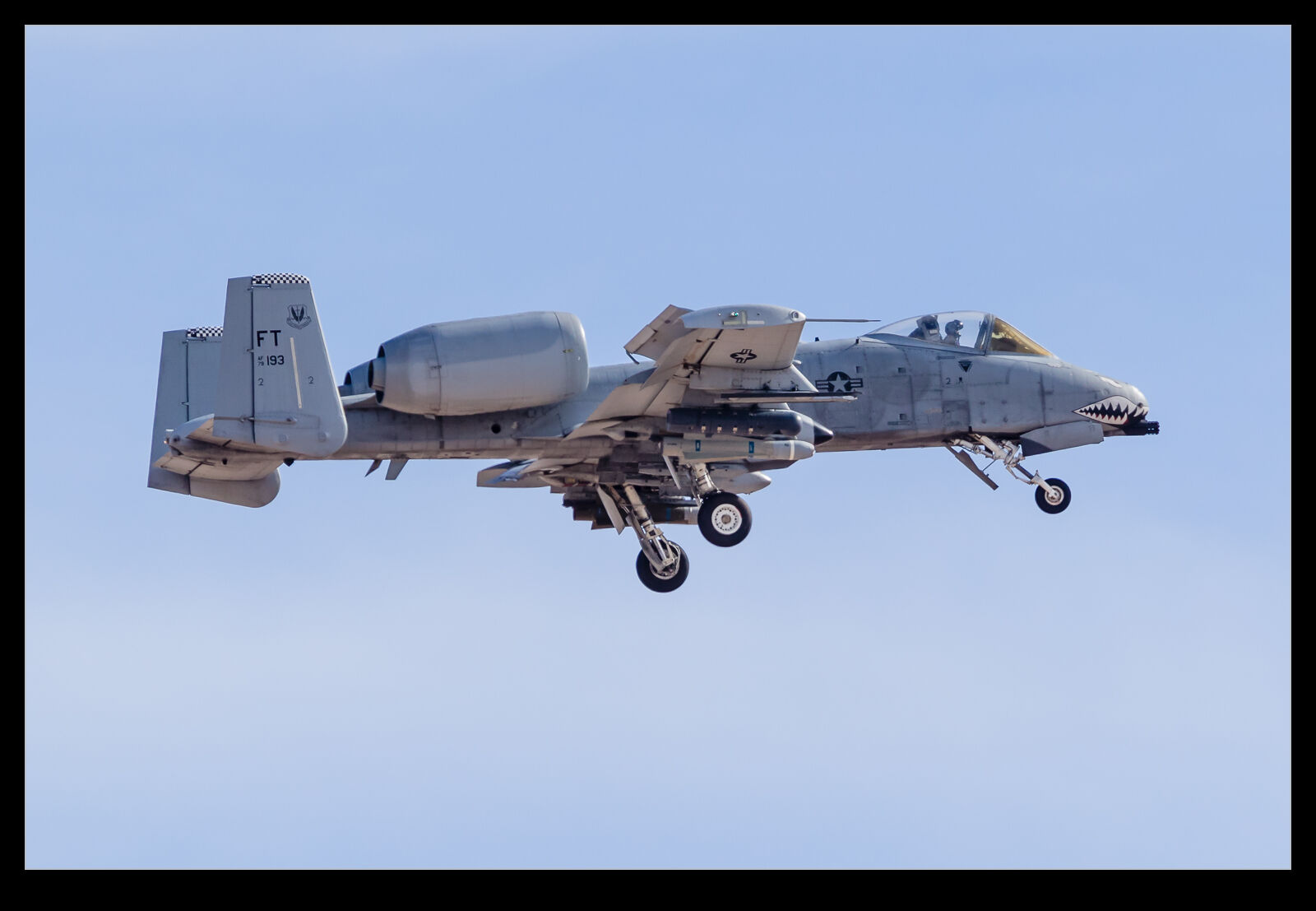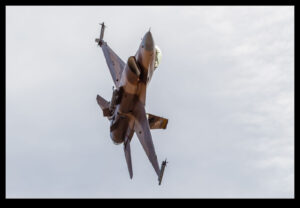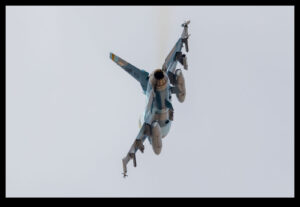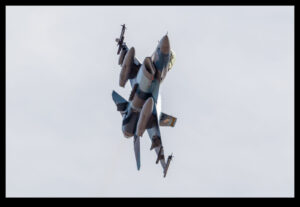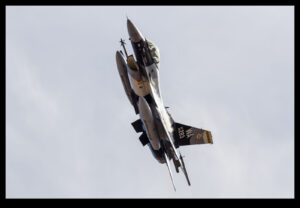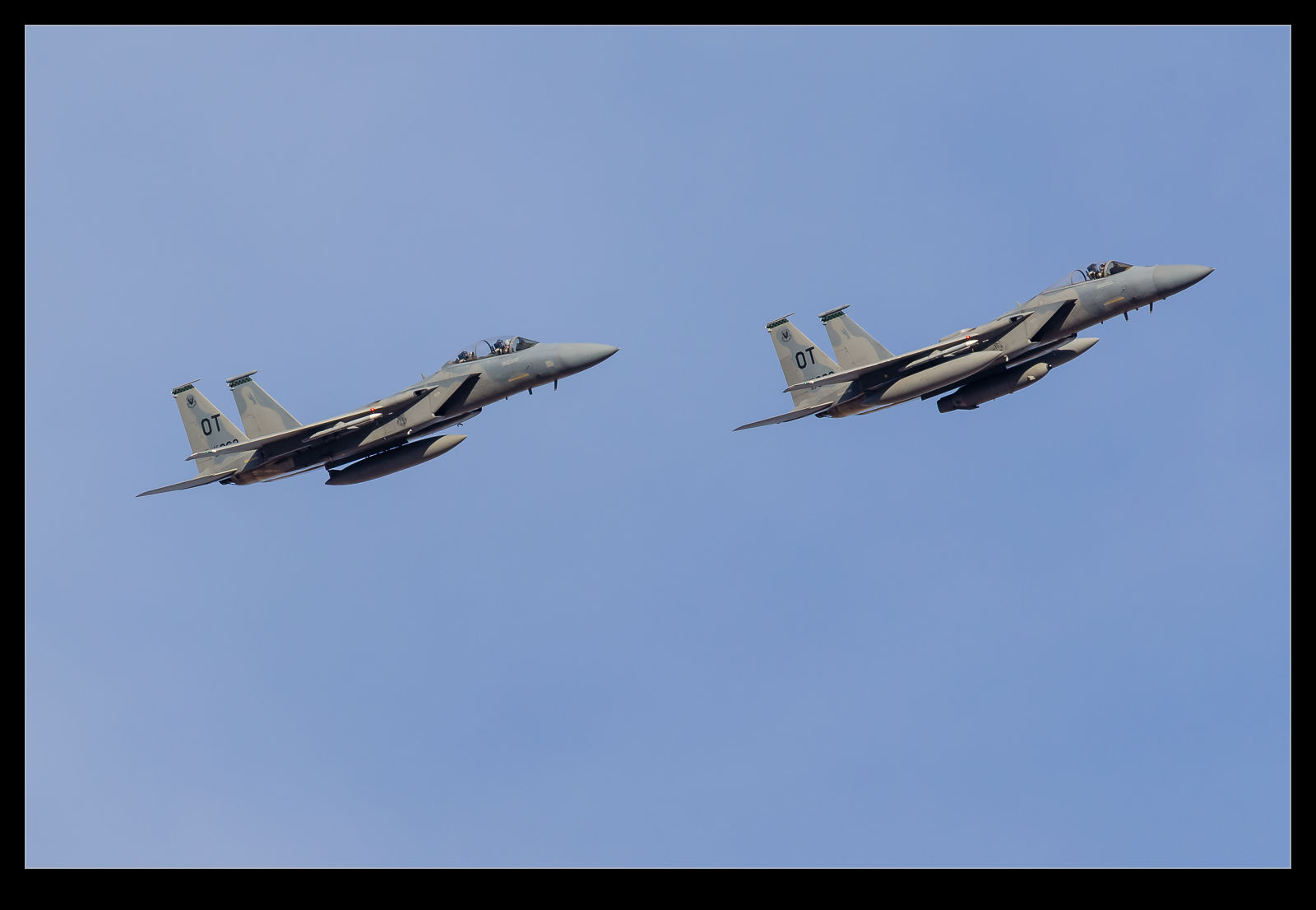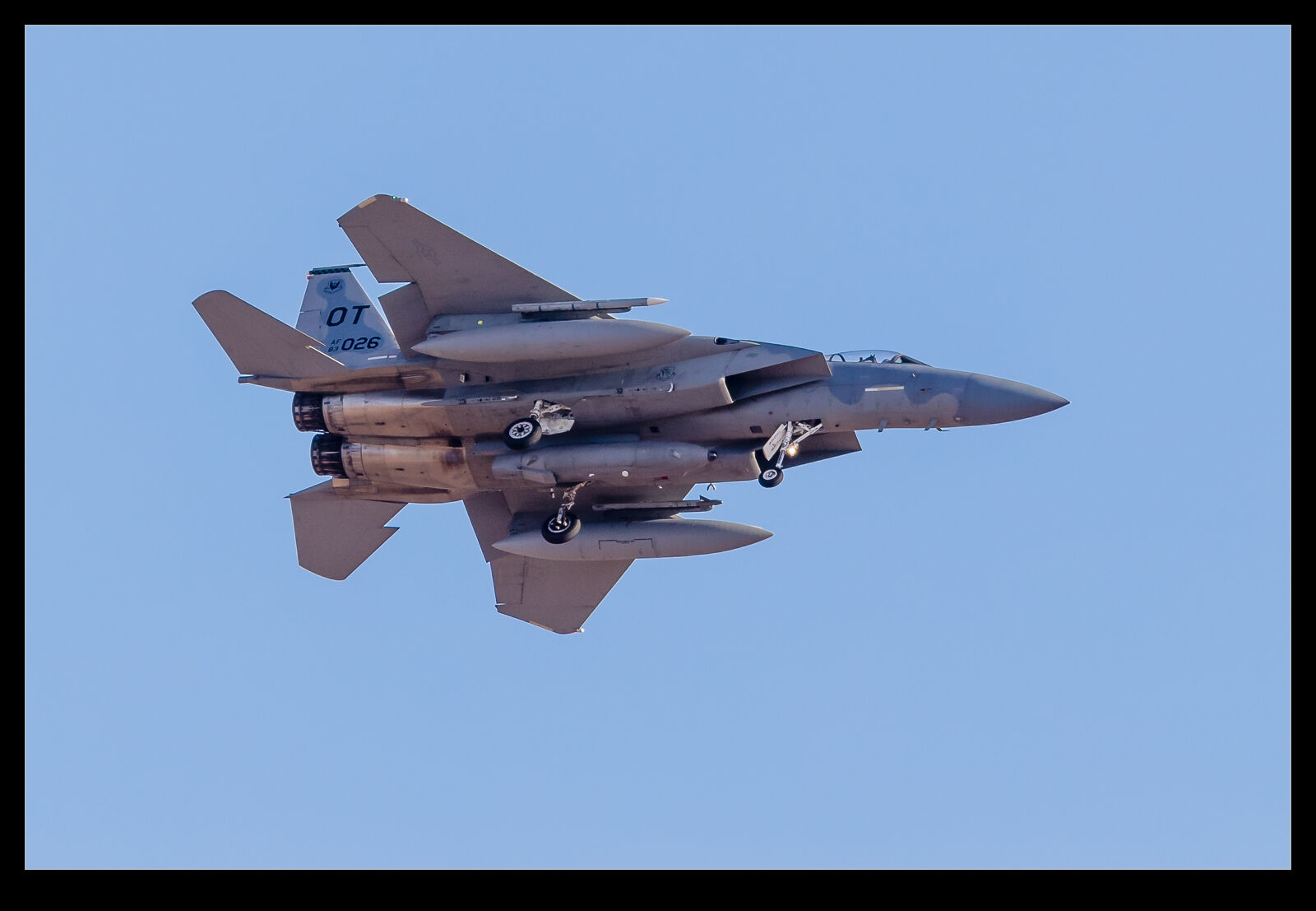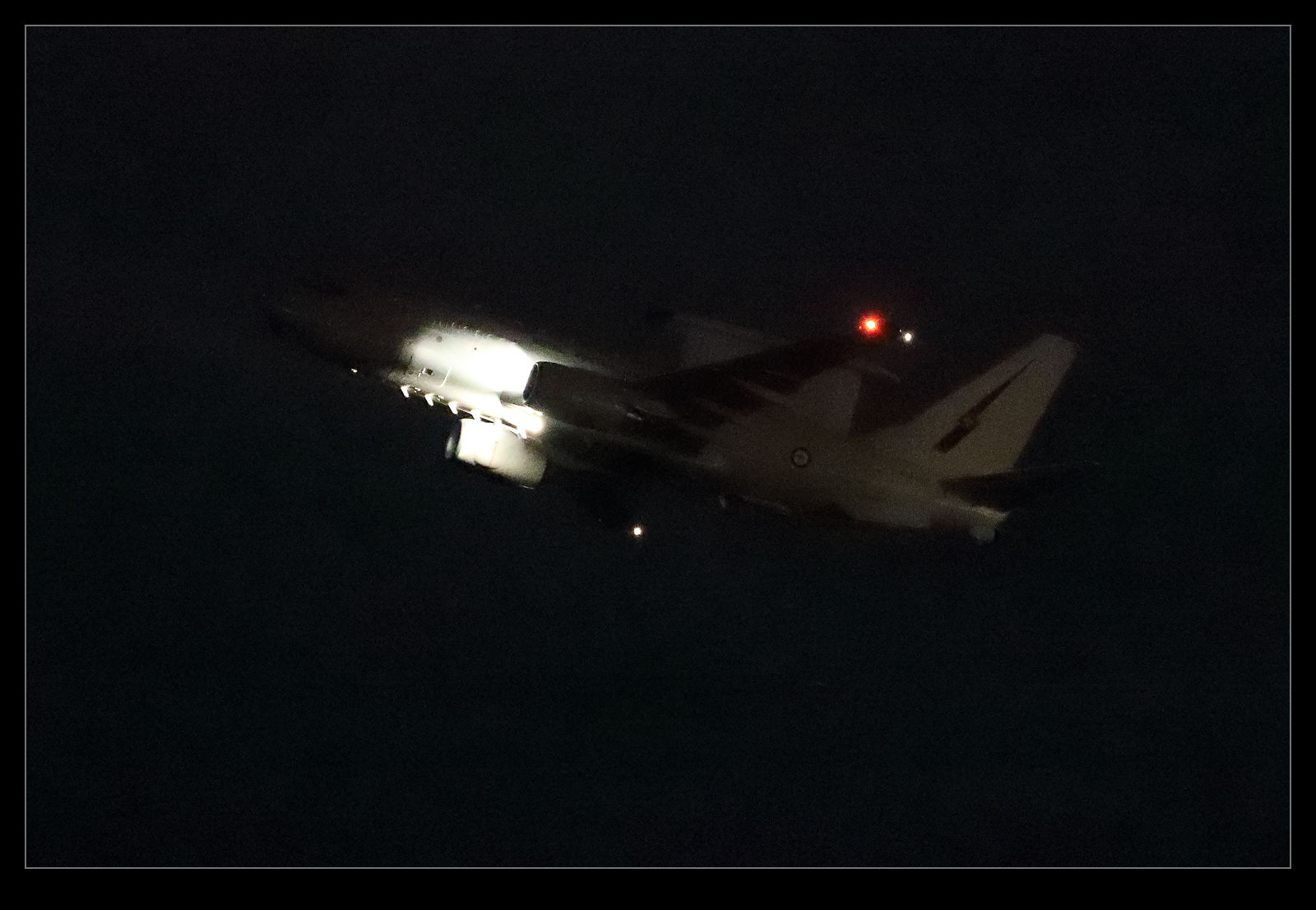 Our overnight stop at Medford in Oregon was close to the airport. I took a stroll towards the terminal which had an F-16 mounted on a pole outside. This was an F-16A model. I assume it had been there for quite a while. There was a time a while back when units would detail bits of their jets with chrome. A-10 guns would be chromed and F-16s would have the port around their guns chromed up too. This jet had obviously had the treatment. The odd thing was that, over the years the paint had become heavily faded. However, the gun port looked exactly like new. These pictures won’t really emphasize this since they were taken wide to get the whole jet in but you might just be able to make out the gun port.
Our overnight stop at Medford in Oregon was close to the airport. I took a stroll towards the terminal which had an F-16 mounted on a pole outside. This was an F-16A model. I assume it had been there for quite a while. There was a time a while back when units would detail bits of their jets with chrome. A-10 guns would be chromed and F-16s would have the port around their guns chromed up too. This jet had obviously had the treatment. The odd thing was that, over the years the paint had become heavily faded. However, the gun port looked exactly like new. These pictures won’t really emphasize this since they were taken wide to get the whole jet in but you might just be able to make out the gun port.
Category Archives: military
Bones Are Cool But Better in Pairs
 Paul and my second full day at Red Flag was also the one where we both had to fly home. We knew that the timing would mean leaving before the last of the big aircraft came home but we should get most of the recovery. We set a time and started packing up. We had done well so no complaints. We hopped in the car and drove towards the turn to take us out to the freeway. Just as we got there, a pair of B-1s came running in to the break in formation. Surely we couldn’t let them go. A rapid stop at the side of the road, grab cameras from the trunk and start shooting.
Paul and my second full day at Red Flag was also the one where we both had to fly home. We knew that the timing would mean leaving before the last of the big aircraft came home but we should get most of the recovery. We set a time and started packing up. We had done well so no complaints. We hopped in the car and drove towards the turn to take us out to the freeway. Just as we got there, a pair of B-1s came running in to the break in formation. Surely we couldn’t let them go. A rapid stop at the side of the road, grab cameras from the trunk and start shooting.
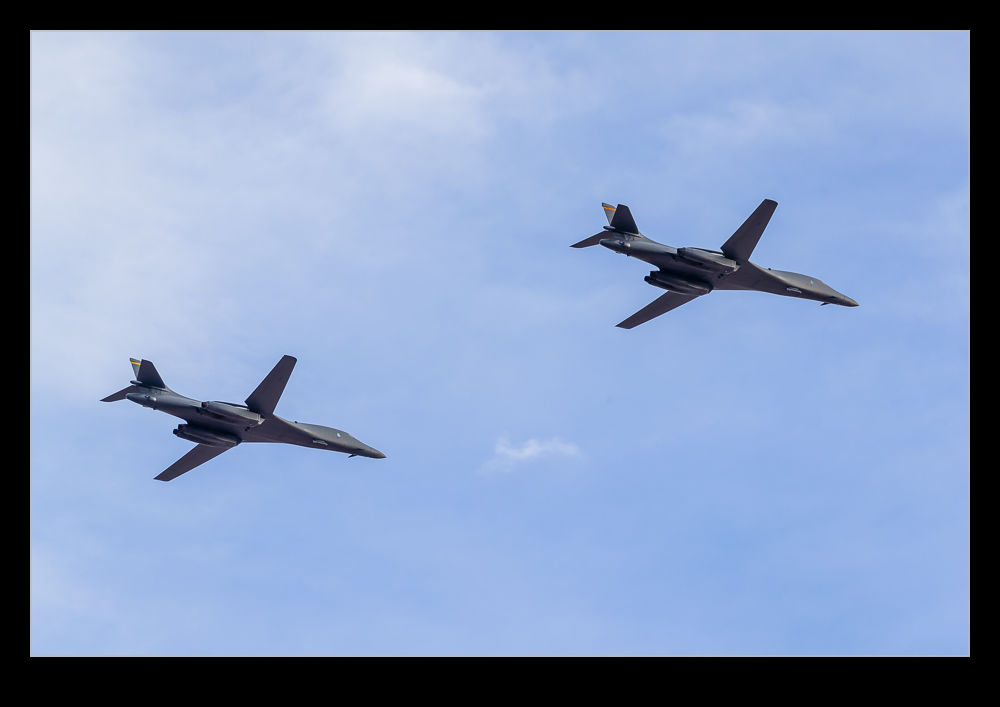 They flew by in formation and broke downwind. Each of them turned in reasonably tight for their approach and it was possible to get some nice topside views as the curved around to final. We could have been a bit closer and probably would have chosen different lenses if we had been able to choose but we got the shots. Then it was time to repack the bags and get going. We only lost about five minutes and everything worked out fin getting back so it was totally worth it. There was no waiting for whatever followed them though.
They flew by in formation and broke downwind. Each of them turned in reasonably tight for their approach and it was possible to get some nice topside views as the curved around to final. We could have been a bit closer and probably would have chosen different lenses if we had been able to choose but we got the shots. Then it was time to repack the bags and get going. We only lost about five minutes and everything worked out fin getting back so it was totally worth it. There was no waiting for whatever followed them though.
Some Raptors Because, Well Why Not?
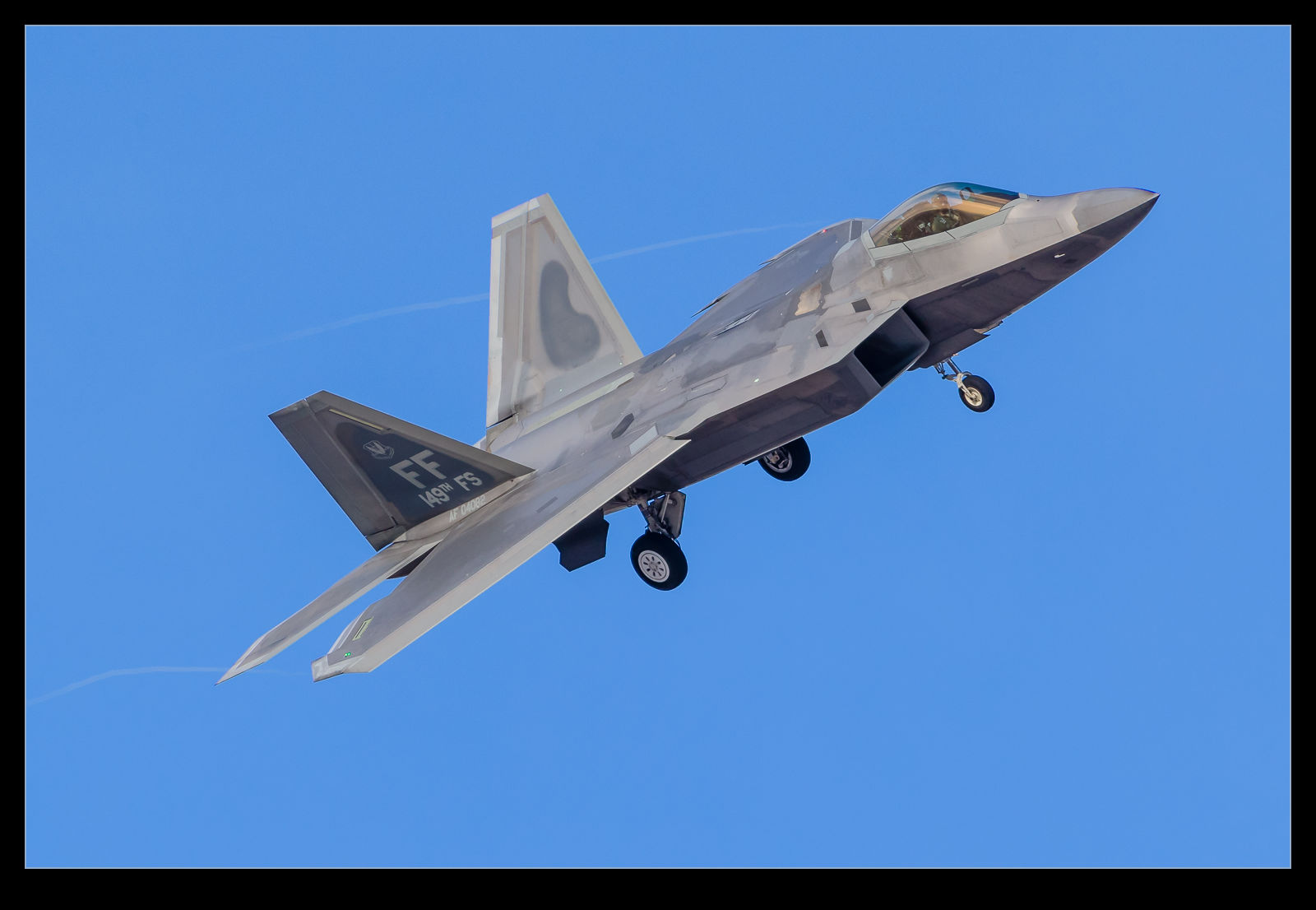 The 1st FW at Langley AFB was the source of the Raptor contribution to Red Flag this year. They weren’t the only F-22s I got to see though. Some of the based aircraft were busy before and after the Red Flag missions so there was plenty of Raptor action. Not much of a story to tell on these. Just a chance to gratuitously show a variety of photos of F-22s because, from the right angle, they look pretty cool!
The 1st FW at Langley AFB was the source of the Raptor contribution to Red Flag this year. They weren’t the only F-22s I got to see though. Some of the based aircraft were busy before and after the Red Flag missions so there was plenty of Raptor action. Not much of a story to tell on these. Just a chance to gratuitously show a variety of photos of F-22s because, from the right angle, they look pretty cool!
- A USAF Lockheed Martin F-22A Raptor on final approach to Nellis AFB NV.
- A USAF Lockheed Martin F-22A Raptor turns on to final approach at Nellis AFB NV.
Stalking the Jollys (Or Are They Stalking Us?)
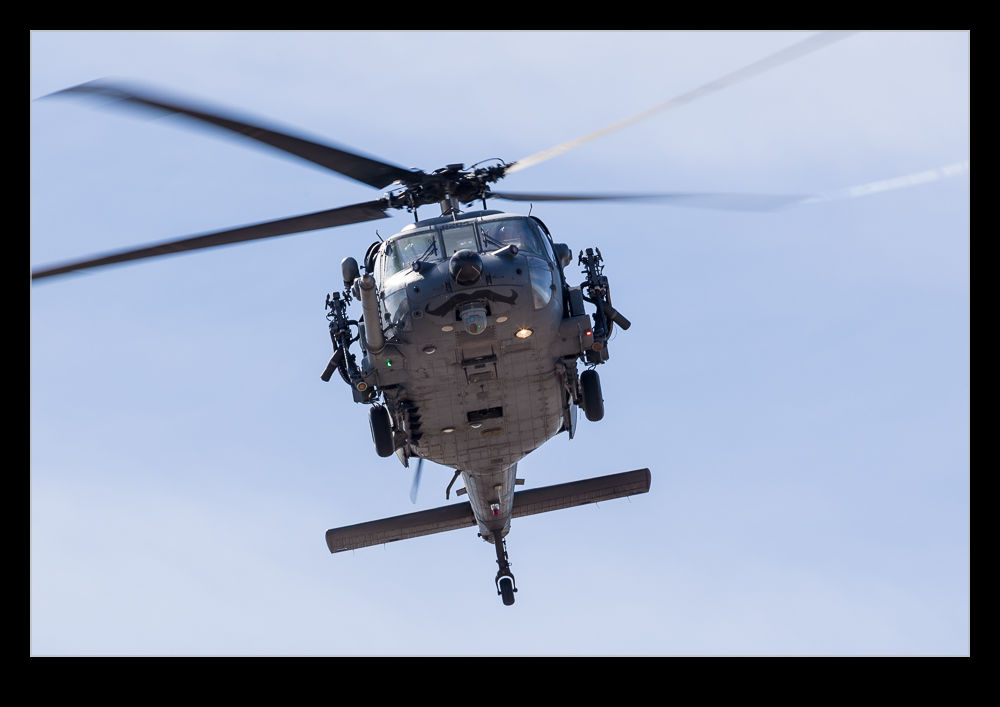 A combat search and rescue element is usually included in Red Flag. The HH-60 Pave Hawk is the usual resource used whether from the locally based unit or from a visiting outfit. When you are set up for the jet action, the helos don’t tend to come anywhere near you. They depart perpendicular to the runways and then head off on course. Two things were different for me on this visit. At one point Paul and I were checking out some other areas when the Hawks launched. We were pretty much directly in the flightpath so we got a good look at the pair as they flew over and headed off to the ranges.
A combat search and rescue element is usually included in Red Flag. The HH-60 Pave Hawk is the usual resource used whether from the locally based unit or from a visiting outfit. When you are set up for the jet action, the helos don’t tend to come anywhere near you. They depart perpendicular to the runways and then head off on course. Two things were different for me on this visit. At one point Paul and I were checking out some other areas when the Hawks launched. We were pretty much directly in the flightpath so we got a good look at the pair as they flew over and headed off to the ranges.
 The other change was that on both days we were there, they turned early and flew out directly over our location at the Speedway en route to their exercise are. I hadn’t seen this before. I was surprised the first time and even more so the second. I assume this was good luck on our part to have them come so close but maybe they were actually following us rather than the other way around?
The other change was that on both days we were there, they turned early and flew out directly over our location at the Speedway en route to their exercise are. I hadn’t seen this before. I was surprised the first time and even more so the second. I assume this was good luck on our part to have them come so close but maybe they were actually following us rather than the other way around?
Late Gear Down for One Warthog
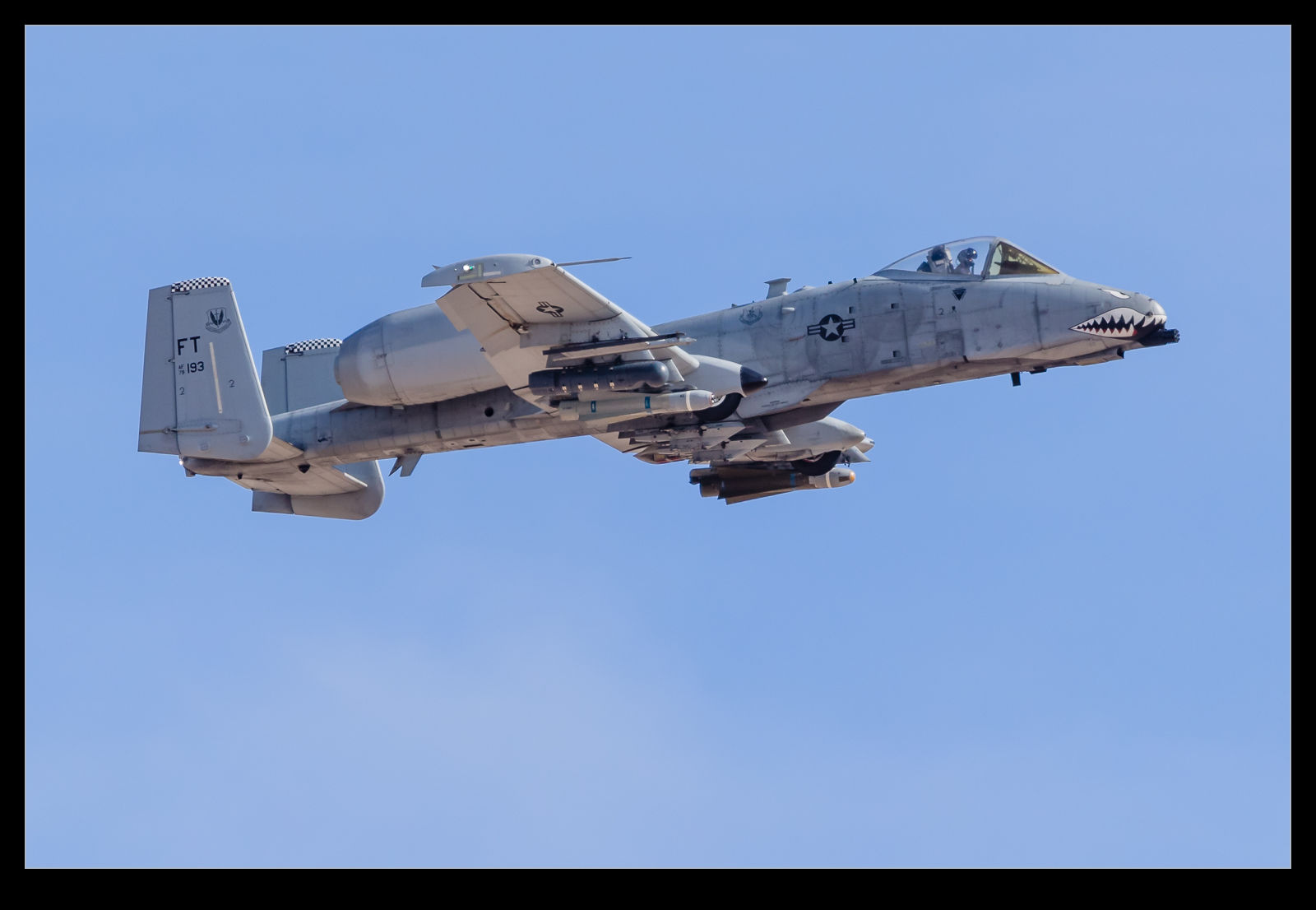 The normal operations at Nellis continue even while Red Flag is on. The local units try to fly their missions at times that fit between the larger exercises. A four ship of A-10s launched in the morning and they were recovering shortly before the Red Flag launch. Rather than run in and break, they flew a straight in approach to runway 21R. Strangely the first jet came passed and it was still gear up as it came close. I have no idea whether they were just keeping it late or had got a call from the tower but the gear came down alongside us. The following three jets were gear down a lot earlier. Let’s say it was deliberate…
The normal operations at Nellis continue even while Red Flag is on. The local units try to fly their missions at times that fit between the larger exercises. A four ship of A-10s launched in the morning and they were recovering shortly before the Red Flag launch. Rather than run in and break, they flew a straight in approach to runway 21R. Strangely the first jet came passed and it was still gear up as it came close. I have no idea whether they were just keeping it late or had got a call from the tower but the gear came down alongside us. The following three jets were gear down a lot earlier. Let’s say it was deliberate…
Head to Head With the Aggressors
 Shooting at Nellis always requires choices to be made. Aside from determining which end you will go to, there is the question about how far up you will go at the Speedway. Some jets turn very tight, others turn long. Some departing jets flex, some flex more tightly than others. Where to go? Paul and I headed up near Gate 7 to see whether we would do alright. As it happened, quite a few of the jets were flexing right overhead us. This didn’t provide the sort of shots we had originally envisaged but, as it turned out, I was rather pleased with the different look.
Shooting at Nellis always requires choices to be made. Aside from determining which end you will go to, there is the question about how far up you will go at the Speedway. Some jets turn very tight, others turn long. Some departing jets flex, some flex more tightly than others. Where to go? Paul and I headed up near Gate 7 to see whether we would do alright. As it happened, quite a few of the jets were flexing right overhead us. This didn’t provide the sort of shots we had originally envisaged but, as it turned out, I was rather pleased with the different look.
 I was getting some very head on shots of some of the aggressor F-16s as the turned towards the ranges. There was even a bit of moisture in the air and the vortices over the root extensions were showing up. That angle has a very dynamic look, even though the lighting in that location is not great for such an angle. The other benefit was as they had passed overhead. You got a close look at the top side of the jet from behind as they flew away. It might not have been what we intended but I was rather pleased with the outcome anyway.
I was getting some very head on shots of some of the aggressor F-16s as the turned towards the ranges. There was even a bit of moisture in the air and the vortices over the root extensions were showing up. That angle has a very dynamic look, even though the lighting in that location is not great for such an angle. The other benefit was as they had passed overhead. You got a close look at the top side of the jet from behind as they flew away. It might not have been what we intended but I was rather pleased with the outcome anyway.
A Lot More of the Talon Hate
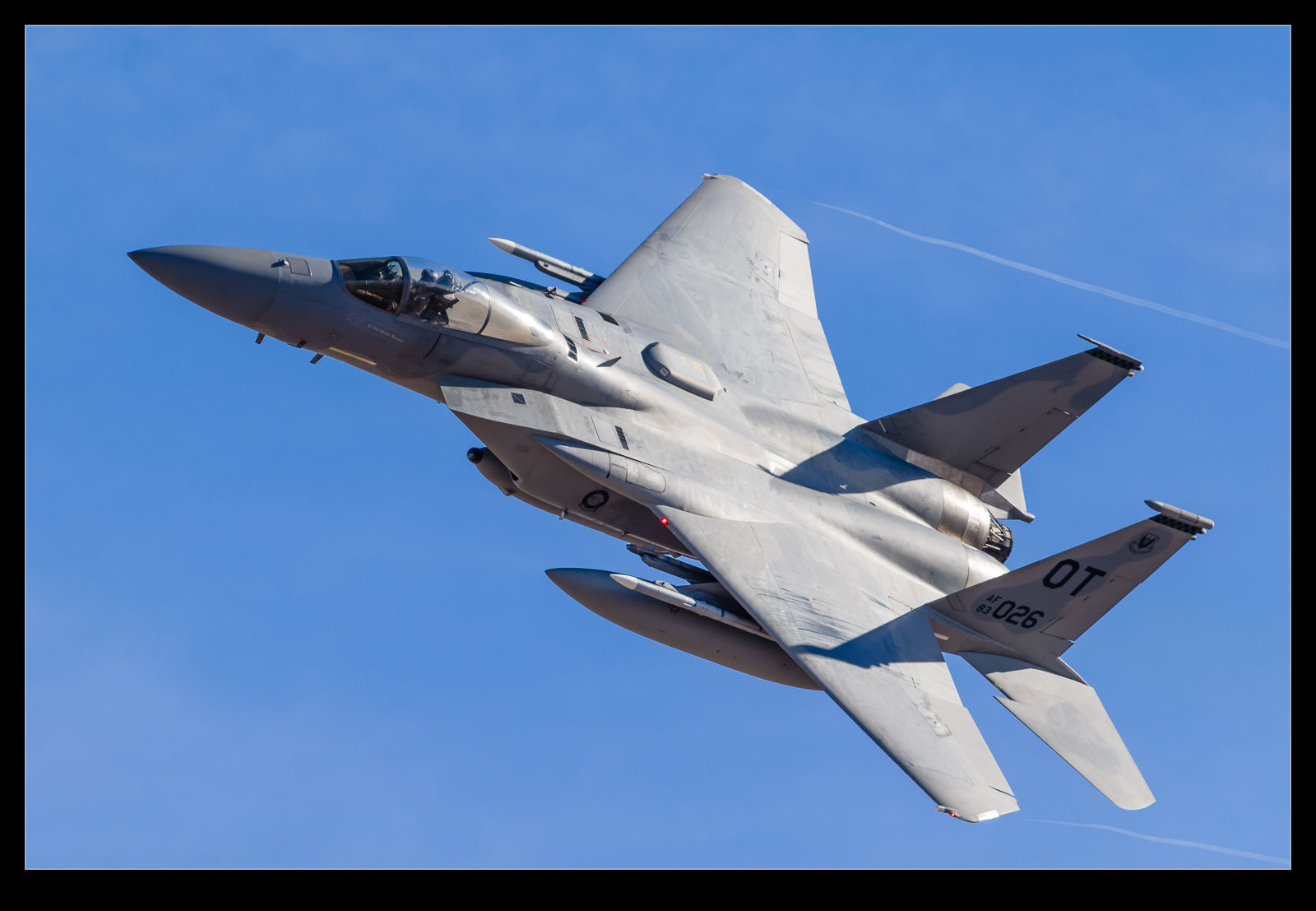 I got some shots of the Talon Hate jet on a previous visit and posted about it here. On this trip to Nellis, not only was it very active but it managed to come our way whenever it flew. Whether it was views of it flexing on departure or tight approaches to bring it passed us on the speedway, it all seemed to work out well. I love the F-15 anyway but getting this special one was a lot of fun. I’m sure the wingman in the F-15D knows that the single-seater is the one we are looking at but they certainly made a good effort to be in position for us to get some good shots of them too. Here are a few of the two of them including a very nice two-ship run in and break.
I got some shots of the Talon Hate jet on a previous visit and posted about it here. On this trip to Nellis, not only was it very active but it managed to come our way whenever it flew. Whether it was views of it flexing on departure or tight approaches to bring it passed us on the speedway, it all seemed to work out well. I love the F-15 anyway but getting this special one was a lot of fun. I’m sure the wingman in the F-15D knows that the single-seater is the one we are looking at but they certainly made a good effort to be in position for us to get some good shots of them too. Here are a few of the two of them including a very nice two-ship run in and break.
It is Dark at Nellis During the Night Launch
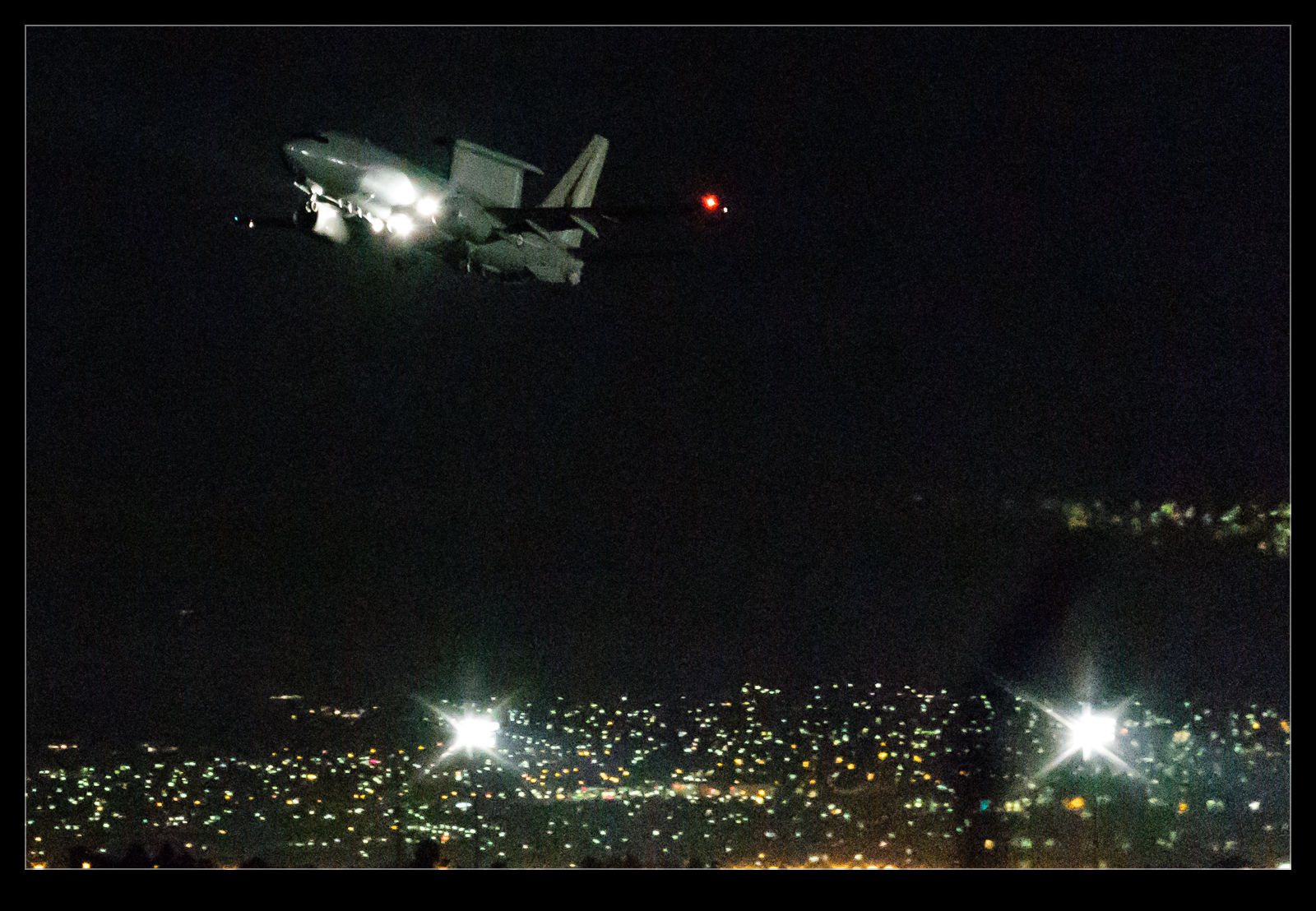 On previous trips to Red Flag I have taken pictures of the departing B-1Bs as they fly overhead. The burners are really impressive and definitely worth getting a shot of from below. However, having done this a few times, I wanted to try something different. The fighter get out of burner very quickly after they get airborne. They are in mil power for ages before they get to you on the centerline. I wanted to see what you could get from the side a lot closer in so Paul agreed to try something different.
On previous trips to Red Flag I have taken pictures of the departing B-1Bs as they fly overhead. The burners are really impressive and definitely worth getting a shot of from below. However, having done this a few times, I wanted to try something different. The fighter get out of burner very quickly after they get airborne. They are in mil power for ages before they get to you on the centerline. I wanted to see what you could get from the side a lot closer in so Paul agreed to try something different.
 We ended up shooting a lot of side on stuff of departures for the night launch. Unfortunately, we didn’t appreciate just how dark it is at Nellis at night. We had a good moon so we were hopeful that there might be some residual light. It turns out that this is not the case. Even close in, the fighters are out of burner. The tankers and the E-7 went out and I got some shots but they were a struggle, event making use of the best high ISO capabilities of the cameras. The B-1s did show up okay but I still didn’t do as well as I thought I should have.
We ended up shooting a lot of side on stuff of departures for the night launch. Unfortunately, we didn’t appreciate just how dark it is at Nellis at night. We had a good moon so we were hopeful that there might be some residual light. It turns out that this is not the case. Even close in, the fighters are out of burner. The tankers and the E-7 went out and I got some shots but they were a struggle, event making use of the best high ISO capabilities of the cameras. The B-1s did show up okay but I still didn’t do as well as I thought I should have.
 I learned a bit about the performance of the cameras. I was shooting at super high ISO settings with the camera wide open. However, as I review the shots, I realize the camera was behaving in a way that I had not anticipated. I was shooting in aperture priority with some negative exposure compensation dialed in. As I look through the shots I see that the camera would start out with a dark shot, gradually boost the exposure and then go dark again. I would review the shots and see one that was looking good but know that the next would be dark.
I learned a bit about the performance of the cameras. I was shooting at super high ISO settings with the camera wide open. However, as I review the shots, I realize the camera was behaving in a way that I had not anticipated. I was shooting in aperture priority with some negative exposure compensation dialed in. As I look through the shots I see that the camera would start out with a dark shot, gradually boost the exposure and then go dark again. I would review the shots and see one that was looking good but know that the next would be dark.
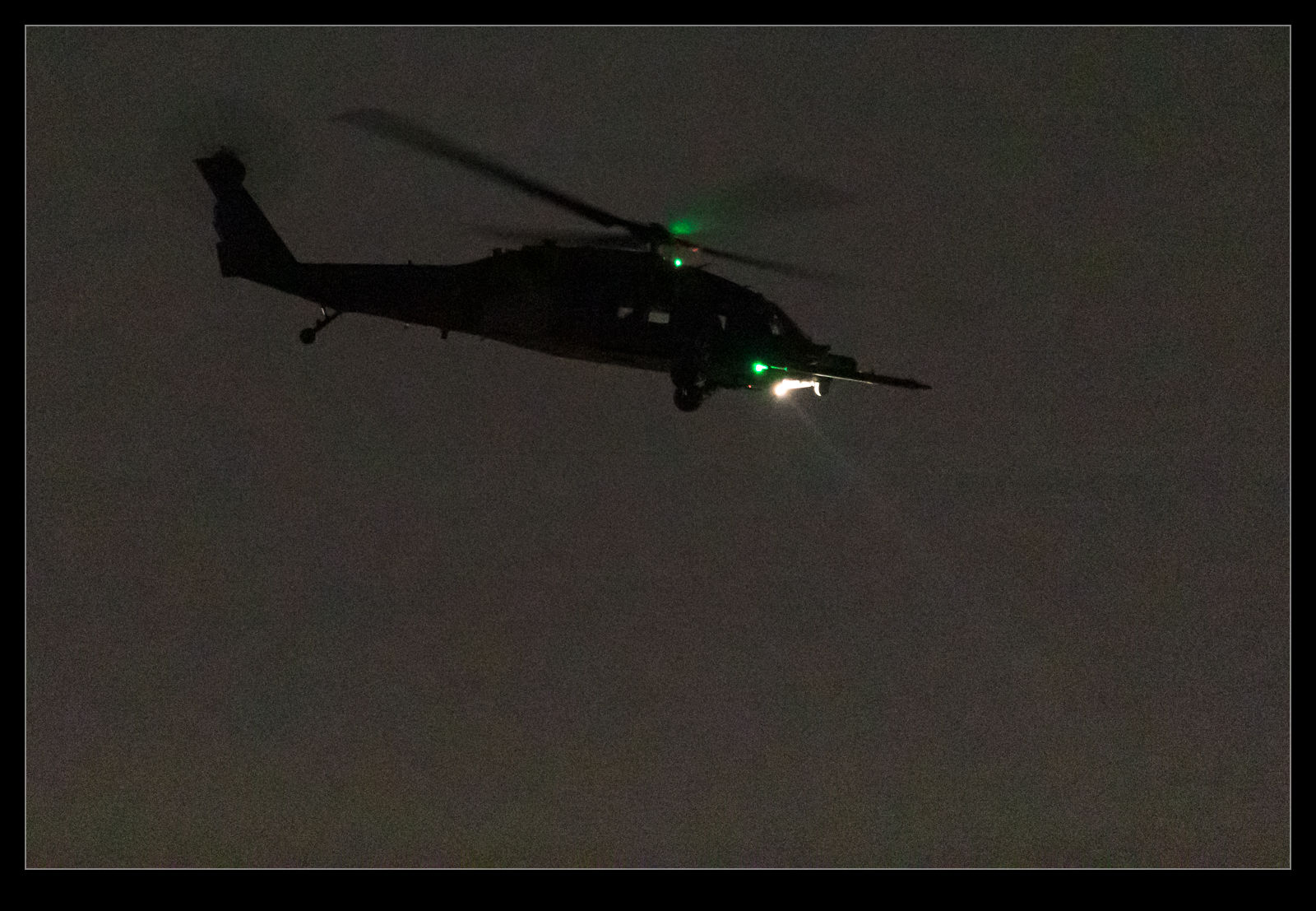 When shooting in such limited light, the shutter speeds are very low and the number of lost shots is high. Therefore, you can’t afford to have the exposure be bad. I don’t know how many shots I lost since they may not have been sharp anyway but I cut down on my opportunities. In future, I need to have all of the exposures be acceptable in order to maximize my opportunities. Therefore, I think I shall have to go fully manual on everything for these shots. Set ISO up high and then go to manual aperture and shutter speed. I will still lose a lot of shots but at least I can focus on dealing with my handholding technique rather than worrying about how the camera is metering a dark night. It’s not too reasonable to expect the camera to get that right every time. It is a pretty extreme case!
When shooting in such limited light, the shutter speeds are very low and the number of lost shots is high. Therefore, you can’t afford to have the exposure be bad. I don’t know how many shots I lost since they may not have been sharp anyway but I cut down on my opportunities. In future, I need to have all of the exposures be acceptable in order to maximize my opportunities. Therefore, I think I shall have to go fully manual on everything for these shots. Set ISO up high and then go to manual aperture and shutter speed. I will still lose a lot of shots but at least I can focus on dealing with my handholding technique rather than worrying about how the camera is metering a dark night. It’s not too reasonable to expect the camera to get that right every time. It is a pretty extreme case!
Blue Angels at Oceana (And High ISO)
 I have only been to the Oceana show once. I headed down there with my friends Ben and Simon. We weren’t terribly lucky with the weather. There was flying during the show but things were overcast and deteriorated as the show went on. The finale of the show was, naturally for a big Navy base, the Blue Angels. I was shooting with a 1D Mk IIN in those days and that was a camera that was not happy at high ISO settings.
I have only been to the Oceana show once. I headed down there with my friends Ben and Simon. We weren’t terribly lucky with the weather. There was flying during the show but things were overcast and deteriorated as the show went on. The finale of the show was, naturally for a big Navy base, the Blue Angels. I was shooting with a 1D Mk IIN in those days and that was a camera that was not happy at high ISO settings.
The problem was, the light was not good and the ISO needed to be cranked up a bit. Amusingly, if you were shooting today, the ISO levels would not be anything that caused concern. Current cameras can shoot at ISO levels without any noise levels that would have been unthinkable back then. However, I did learn something very important with this shoot. The shot above is one that I got as one of the solo jets got airborne. I used it as a test for processing.
 I processed two versions of the image, one with a lot of noise reduction dialed in and one with everything zeroed out. I think combined them in one Photoshop image and used a layer mask to show one version in one half of the image and the other for the second half. When I viewed the final image on the screen, the noise in one half was awfully apparent. It was a clear problem. However, I then printed the image. When I did so, things were very different. If you looked closely, you could see a little difference. However, when you looked from normal viewing distances, there was no obvious difference between the two.
I processed two versions of the image, one with a lot of noise reduction dialed in and one with everything zeroed out. I think combined them in one Photoshop image and used a layer mask to show one version in one half of the image and the other for the second half. When I viewed the final image on the screen, the noise in one half was awfully apparent. It was a clear problem. However, I then printed the image. When I did so, things were very different. If you looked closely, you could see a little difference. However, when you looked from normal viewing distances, there was no obvious difference between the two.
My takeaway from this is that viewing images on screens has really affected our approach to images. We get very fixated on the finest detail while the image as a whole is something we forget. We print less and less these days and the screen is a harsh tool for viewing.
Some Spare Oxygen – Just in Case
 There have been quite a few Raptor posts recently. I guess seeing a bunch of them at Nellis triggered a few things of interest to me. One was as I looked at the jets after they had passed me by on their approach. A few years ago, the F-22 fleet was grounded by some issues with the oxygen system. Like most modern jets, the F-22 doesn’t carry bottled oxygen but instead generates it onboard for the pilot. There were some issues with the oxygen being generated that resulted in pilots feeling unwell and, potentially, losing awareness of what they were doing. As you can image, this is not a good thing in a fast jet and was believed to have contributed to loss of an aircraft with its pilot!
There have been quite a few Raptor posts recently. I guess seeing a bunch of them at Nellis triggered a few things of interest to me. One was as I looked at the jets after they had passed me by on their approach. A few years ago, the F-22 fleet was grounded by some issues with the oxygen system. Like most modern jets, the F-22 doesn’t carry bottled oxygen but instead generates it onboard for the pilot. There were some issues with the oxygen being generated that resulted in pilots feeling unwell and, potentially, losing awareness of what they were doing. As you can image, this is not a good thing in a fast jet and was believed to have contributed to loss of an aircraft with its pilot!
A backup oxygen system was implemented to provide the pilots with something in the event that they felt symptoms of the problem recurring. Not so much of a solution as a fallback plan. As I looked at the jets, I saw green tanks behind the ejection seat. These are pretty big tanks and seem rather unsubtle in the way that something that has been added after the fact often is. I wonder whether these are the spare tanks for the pilots to breathe should the onboard generation system cease to be reliable.

